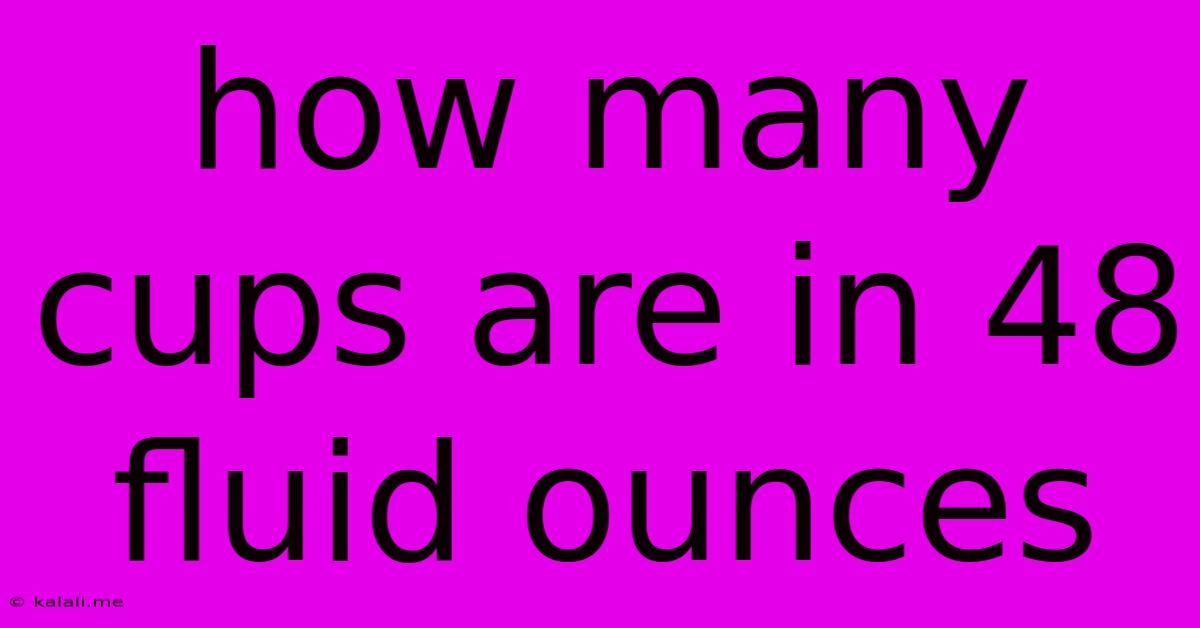How Many Cups Are In 48 Fluid Ounces
Kalali
Apr 14, 2025 · 4 min read

Table of Contents
How Many Cups Are in 48 Fluid Ounces? A Comprehensive Guide to Volume Conversions
Knowing how many cups are in 48 fluid ounces might seem like a simple question, but it's a fundamental concept in cooking, baking, and everyday measurements. This comprehensive guide will not only answer that question directly but delve deeper into the intricacies of volume conversions, providing you with the knowledge and tools to confidently tackle any similar measurement challenge. This article will also cover related topics, such as converting fluid ounces to pints, quarts, and gallons, offering a complete understanding of the US customary system of liquid measurement.
Understanding Fluid Ounces and Cups
Before we dive into the conversion, let's clarify the units involved. A fluid ounce (fl oz) is a unit of volume in the US customary system. A cup (c) is also a unit of volume, commonly used in cooking and baking recipes. The relationship between these two units is crucial for accurate conversions. In the US customary system, 1 cup is equal to 8 fluid ounces.
Calculating Cups from Fluid Ounces: The Simple Answer
The question, "How many cups are in 48 fluid ounces?" is easily solved using the fundamental conversion factor:
48 fluid ounces / 8 fluid ounces/cup = 6 cups
Therefore, there are 6 cups in 48 fluid ounces.
Beyond the Basic Conversion: Exploring Related Volume Units
While knowing that 48 fluid ounces equals 6 cups is valuable, understanding the broader context of volume measurement within the US customary system enhances practical application. This understanding is vital whether you're scaling up a recipe, pouring liquids for a science experiment, or simply trying to visualize quantities. Let's explore the relationships between fluid ounces and other common volume units:
Pints:
- 1 pint (pt) = 16 fluid ounces
To convert 48 fluid ounces to pints:
48 fluid ounces / 16 fluid ounces/pint = 3 pints
Therefore, 48 fluid ounces is equal to 3 pints.
Quarts:
- 1 quart (qt) = 32 fluid ounces or 2 pints
To convert 48 fluid ounces to quarts:
48 fluid ounces / 32 fluid ounces/quart = 1.5 quarts
Therefore, 48 fluid ounces is equal to 1.5 quarts.
Gallons:
- 1 gallon (gal) = 128 fluid ounces or 4 quarts or 8 pints
To convert 48 fluid ounces to gallons:
48 fluid ounces / 128 fluid ounces/gallon = 0.375 gallons
Therefore, 48 fluid ounces is equal to 0.375 gallons or approximately 3/8 of a gallon.
Practical Applications of Volume Conversions: Recipes and Beyond
Understanding these conversions is not merely an academic exercise; it has countless practical applications in various aspects of life:
-
Cooking and Baking: Scaling recipes up or down requires accurate conversions. If a recipe calls for 12 fluid ounces of milk, and you want to double the recipe, you'll need 24 fluid ounces, which is equivalent to 3 cups.
-
Beverage Preparation: Knowing the volume of liquids is essential for bartending, mixology, and preparing large batches of beverages. A punch recipe requiring 48 fluid ounces of juice can easily be visualized as 6 cups or 3 pints.
-
Scientific Experiments: Many scientific experiments require precise measurements of liquids. Accurately converting fluid ounces to other units is crucial for experimental reproducibility and accuracy.
Troubleshooting Common Measurement Issues:
While the conversions are straightforward, some common issues can arise:
-
Using Different Measuring Tools: The accuracy of your conversions depends on the accuracy of your measuring tools. Using a miscalibrated measuring cup or a dented measuring jug can lead to inaccurate results.
-
Liquid Density: The conversions we've discussed assume a standard liquid density. However, the density of liquids can vary. For example, honey is denser than water, meaning that 48 fluid ounces of honey will weigh more than 48 fluid ounces of water. For highly viscous substances or those with significantly different densities than water, specialized measurement techniques may be necessary.
-
Metric Conversions: If you're working with metric units, you'll need to use different conversion factors. One fluid ounce is approximately equal to 29.57 milliliters (mL). Therefore, 48 fluid ounces are approximately equal to 1419.36 mL.
Mastering Volume Conversions: Tips and Tricks
To become proficient in volume conversions:
-
Memorize key conversion factors: Remembering that 1 cup equals 8 fluid ounces is the foundation for many other conversions.
-
Practice regularly: The more you practice converting between different units, the easier it will become.
-
Use online conversion tools: Several online tools can quickly and accurately perform volume conversions. However, understanding the underlying principles remains crucial.
-
Understand the context: Always consider the context of the measurement. Are you dealing with a liquid that has a significant viscosity or a specific density? This influences the accuracy of your conversion.
Conclusion:
In conclusion, 48 fluid ounces equals 6 cups. Understanding this fundamental conversion, along with the broader context of the US customary system of liquid measurement, is vital for various applications. Mastering volume conversions is a valuable skill that enhances accuracy and efficiency in cooking, baking, scientific experiments, and many other daily tasks. By understanding the principles and practicing regularly, you'll confidently navigate the world of volume measurements. This knowledge empowers you to tackle recipes, experiments, and other tasks with precision and expertise.
Latest Posts
Latest Posts
-
What Is 20 Percent Of 800 000
Jul 12, 2025
-
Words That Start With Y In Science
Jul 12, 2025
-
Prevent An Expressway Emergency By Merging Without
Jul 12, 2025
-
How Many Grams Of Sugar In A Pound
Jul 12, 2025
-
7am To 11am Is How Many Hours
Jul 12, 2025
Related Post
Thank you for visiting our website which covers about How Many Cups Are In 48 Fluid Ounces . We hope the information provided has been useful to you. Feel free to contact us if you have any questions or need further assistance. See you next time and don't miss to bookmark.